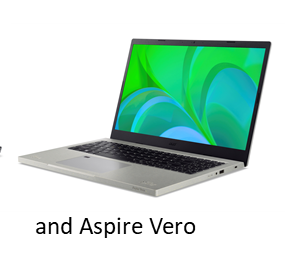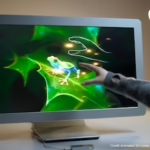Windows 11, <$1k, 15-inch 144 Hz HD

Acer America announced the Aspire Vero notebook. The company says it is their first sustainability-focused product. It is one of Acer’s first products powered by Windows 11, is eco-friendly, EPEAT Silver-certified, which features post-consumer recycled (PCR) plastic throughout the chassis and keyboard with 100% recyclable packaging. It also has antimicrobial Corning gorilla glass, an alkali-aluminosilicate thin sheet glass formulated with an antimicrobial agent to help keep the glass surface clean of stain and odor-causing bacteria. Trace amounts of silver ions leach to the glass surface to eliminate the surface bacteria in multiple modes. Prices start at $700.
The Aspire has an 11th Gen Intel Core i7 processor with Intel Iris Xe graphics, and up to 512GB of M.2 SSD storage. The 15.6-inch FHD IPS display and an AI noise suppression offers clarity during video calls. The notebook also comes with Intel Wi-Fi 6 (Gig+), a USB Type-C port, two USB 3.2 ports and an HDMI 2.0 port for video-out.
The Aspire Vero’s 100% recyclable packaging earned it a 2021 Red Dot Award for Brand & Communication Design. The laptop protective bag and keyboard are comprised of 100% recycled plastic and the protective carton box includes up to 85% recycled materials. In addition, Acer cooperates with vendors to encourage the replacement of all plastic bags with paper adapter protection sleeves. Acer even designed the box remnants to fold into a stable computer stand with multiple customizable angles and options for daily use.
Acer also announced its popular Swift 5 (SF514-55TA), an ultrathin and light notebook with an uber-stylish design, will be available with Windows 11, and also offers an antimicrobial solution in an ultraportable package. Acer’s newest Nitro 5 notebooks (AN515-57 and AN515-54) bring the latest technologies to gamers who want the most bang for their buck by offering a good balance of powerful features with a stylish design at affordable prices. The Swift 5 ultrathin and light notebook also has the antimicrobial Glass screen and antimicrobial chassis solution with pricing starting at $1,100.
The Swift 5 has a durable yet lightweight magnesium-lithium and magnesium-aluminum chassis and weighs about 2.29 lbs. The chassis, touchpad, keyboard, and all covers of the device have also been treated with a BPR & EPA-compliant silver-ion antimicrobial solution.
The Swift 5 has a 14-inch Full HD display with a 340-nit brightness rating and 100% sRGB color gamut. In addition, the display has ultra-narrow bezels on all four sides, resulting in a 90% screen-to-body ratio.
Acer’s new Nitro 5 gaming notebooks will have Windows 11 later this month. Gamers can choose from models with a 15.6-inch or 17.3-inch 144 Hz FHD display, an 11th Gen Intel Core i5 or Core i7 processor, and an Nvidia GTX 1650 or RTX 3050Ti GPU. Prices start at $770. The 17.3-inch Nitro 5 with a 144 Hz FHD display, an 11th Gen Intel Core i7 processor, 16GB DDR4 memory, and a 1TB SSD starts at USD $1,200.
What do we think?
So, do three Windows 11 notebooks equal Windows 33?
If you think about it, the high-tech industry has traditionally been early in on sustainability issues from computer recyclability to monitor emissions. But, that’s not to ignore the damage done in the first place by the materials used throughout the computer industry. The materials used in semi-conductor manufacture are pretty horrific, which is why some Fabs are in Asia and one worth notable is in Arizona. Taiwan-based TSMC has pledged to reach zero emissions by 2050. In a recent article in the Guardian, it’s reported that Intel’s fab in Ocotillo, Arizona uses vast amounts of water and produced 15,000 lbs of waste in the first 3 months of 2021, 60% of it hazardous. In its defense, Intel has published this page to document what’s happening and what the company is doing about it.
So, the point of this little barely relevant digression is that yes, the high-tech industry has greatly contributed to pollution and global warming and yes, it is trying to step up. As the Guardian notes making semiconductors helped get us into this mess, but we’ll be relying on semiconductors to get us out. It’s a matter of better late than never and it is pretty late.






